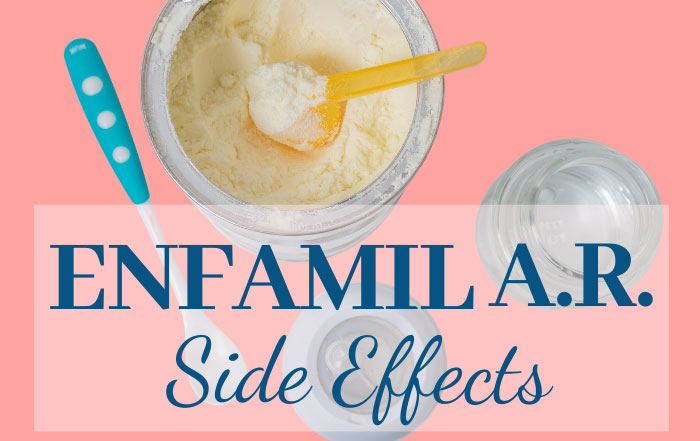Spit-up or reflux is experienced by various parents and is expected in healthy babies. However, when the issue becomes too severe, parents lookout for every possible solution. Enfamil A. R. is one such solution that various parents recommend. However, if you are concerned whether Enfamil A.R is harmful to your baby, this detailed article is for you.
In this article, I have covered all the essential facts and information related to Enfamil A. R., including its composition and comparison with RDA, mechanism of action and its efficacy, and all the parents’ concerns and side effects and research studies.

What is Enfamil A. R.?
Enfamil A. R. is a specially formulated formula for infants who spit-up or has gastroesophageal reflux (GER). This formula has a thicker consistency, and it is claimed to reduce spit-ups by 50% within a week. This claim is based on a clinical study that is briefly described on their website.
If you are wondering, in Enfamil A. R., what does A. R. stands for? A. R. stands for anti-regurgitation or anti-reflux.
Is it clinically tested?
Like every health product (medicine and supplements), Enfamil A. R. is also scientifically tested by this formula’s brand.
The Enfamil brand conducted a clinical trial to test this formula’s efficacy for babies who spit-up five times or more in a day. They gave the Enfamil A.R. to babies before adding other nutrients like DHA, ARA, and prebiotics. The babies who consumed this formula showed reduced frequency and volume of spit-ups.
Enfamil A.R. is formulated to fulfill the nutritional needs of babies up to 12 months who spit-up frequently. It is also mentioned that parents highly recommend Enfamil A.R. to ease spit-up and gastroesophageal reflux.
Enfamil A.R. and American Academy of Pediatrics guidelines for gastroesophageal reflux (GER)
The brand also asserted that this formula fulfills the reflux reduction guidelines established by the American Academy of Pediatrics.
According to the Parent’s guide to gastroesophageal reflux and gastroesophageal reflux disease devised under American Academy of Pediatrics supervision, babies with reflux should be given thickened formula. They suggested the use of one tablespoon of rice cereal in a single ounce of formula.
Nutrients in Enfamil AR and consumption as per Recommended Dietary Allowance
Enfamil A. R. is enriched with the following nutrients, vitamins, and minerals.
| Nutrients | Amount in 5 fl. oz. of Enfamil A. R. |
| Protein | 2.5 g |
| Fat | 5.1 g |
| Carbohydrate | 11.3 g |
| Water | 133 g |
| Linoleic acid | 780 mg |
| Minerals | Amount in 5 fl. oz. of Enfamil A. R. | RDA (0 to 6 months) | RDA (7 to 12 months) |
| Calcium | 78 mg | 200 mg | 260 mg |
| Phosphorus | 53 mg | 100 mg | 275 mg |
| Magnesium | 8 mg | 30 mg | 75 mg |
| Iron | 1.8 mg | 0.27 mg | 11 mg |
| Zinc | 1 mg | 2 mg | 3 mg |
| Manganese | 15mcg | 3 mcg | 600 mcg |
| Copper | 75 mcg | 200 mg | 200 mg |
| Iodine | 15 mcg | 110 mcg | 130 mcg |
| Selenium | 2.8 mcg | 15 mcg | 20 mcg |
| Sodium | 40 mg | 0.4 gm | 0.4 gm |
| Potassium | 108 mg | 400 mg | 860 mg |
| Chloride | 75 mcg | 0.3 gm | 0.3 gm |
| Vitamins in 5 fl. oz. | |||
| A | 300 IU | 1333 IU | 1667 IU |
| D | 60 IU | 400 IU | 400 IU |
| E | 2 IU | 2.5 IU | 3 I.U. |
| K | 9 mcg | 2 mcg | 2.5 mcg |
| Thiamin (B1) | 80 mcg | 200 mcg | 300 mcg |
| Riboflavin (B2) | 140 mcg | 300 mcg | 400 mcg |
| B6 | 60 mcg | 100 mcg | 300 mcg |
| Niacin | 1000 mcg | 2000 mcg | 4000 mcg |
| Folic acid (folacin) | 16 mcg | 65 mcg | 80 mcg |
| Biotin | 3 mcg | 5 mcg | 6 mcg |
| C (ascorbic acid) | 12 mg | 40 mg | 50 mg |
| Choline | 24 mg | 125 mg | 150 mg |
| Inositol | 6 mcg | N.E. | N.E. |
| Pantothenic acid | 500 mcg | 1700 mg | 1800 mg |
N.E. = Not Established
The above mentioned are the contents present in Enfamil A.R. and the recommended dietary allowance per day for infants’ minerals and vitamins. The RDA values are authenticated from the National Institutes of Health, Office of Dietary Supplements, U.S. Department of Health and Human Services. The comparison of the values suggests that all the content present in this formula is according to the infants’ RDA.
Enfamil A. R. powder vs. ready to use formula
This formula is available in powder form and also in the form of ready-to-use formula feeding packages. Some parents and babies prefer powdered formula, while some babies only go with the ready-to-use feeding formulas.
The website claims that both powder and ready-to-feed formulas are the same, and there is no difference in the contents and nutrients. However, considering parents’ reviews on different forums, blogs, and websites, it is evident that these are not the same.
Moreover, it is also established by a recent study (Pados & Feaster, 2021) the Enfamil A.R. powder and ready to use has a significant difference in the flow rate. Enfamil A. R. powder has a slower flow rate as compared to the ready-to-use formula.
Parents find ready-to-use formula more effective as compared to powder formula. It is because of different water temperatures or the nature of water content, the difference in the amount of formula powder, too slow or too rigorous mixing of the formula, and the duration of prepared formula storage.
Enfamil A. R. reviews for reflux or GER
Enfamil A. R. is a rice-thickened formula and is found to be effective for infants with GER. The parents give positive reviews of this formula, and it resolves the spit-up issue significantly.
There are a total of 880 reviews of Enfamil A.R. on the Enfamil website. Among these reviews, 621 customers gave 5 stars, 149 customers gave 4 stars, 36 customers gave 3 stars, 23 customers gave 2 stars, and 51 customers gave 1 star.
These reviews suggest that most of the parents are satisfied with this product and serve its purpose. Parents reported a reduction in volume and frequency of reflux. Various parents found it life-changing for their babies. Parents say it shows results within a week, and their babies don’t spit up at all after having this formula.
However, some bad reviews cannot be ignored, and I will discuss those under the side effects of Enfamil A. R.
How does Enfamil A. R. work?
Before moving further, let’s look at some scientific research studies and articles that will help us understand the impact of thickened formulas like Enfamil A. R. on GER.
Feed thickeners enhance the viscosity or stickiness of the milk. It helps in holding and retaining the stomach’s food (Kwok, Ojha & Dorling, 2018). Moreover, the thickness of the food and increased viscosity make it difficult for food content to travel up to the esophagus (Duncan, Larson, & Rosen, 2019). It thus controls the movement of the upper esophageal sphincter and reduces gastroesophageal reflux or spit-ups.
Is Enfamil A. R. actually effective for the management of reflux?
Apart from the parents’ reviews, I shared above. Various research studies suggested that thickened formulas and feeds effectively control GER and regurgitation. However, some studies reported the moderate to minimal positive impact of food thickeners on reflux in babies.
Horvath, Dziechciarz, and Szajewska (2008) conducted a review of the research studies that studied the efficacy of thickened-feedings on GER. The researchers suggested that feed-thickeners moderately reduced the GER in healthy babies.
Hegar and colleagues (2008) also yield similar results when conducting an experimental study with three groups of infants having a reflux problem. One group was given standard infant formula. The second group was given standard formula thickened with rice cereal. The third group was given manufactured formula with bean gum as a thickening agent.
The researchers assessed the reflux after a month, and all three groups reported a decrease in the reflux. However, the manufactured formula was a little more efficacious in reducing the reflux.
However, as Duncan and colleagues (2019) asserted, every thickening agent acts differently for different infants. So, we cannot say for sure that yes, this is the best formula for every baby. You have to go through a trial and error method to find the right formula for your baby.
What are Enfamil AR side effects?
After going through the basics of Enfamil A. R., let’s focus on the negative reviews and criticism on Enfamil A. R. Several parents consider this formula a magic solution for their babies, while for other parents using this formula was a waste of money and effort. So, why is it that some parents love it and some parents hate it?
Enfamil A. R. is a thickened formula and has rice cereal as a thickening agent. The use of thickened feed has potential benefits. Still, there are also some side effects, concerns, and risks of using thickeners in the baby feed.
The following are the parents’ critical issues and validated by scientific research (Duncan et al., 2019).
Does Enfamil A. R. cause constipation and gas?
Constipation is the primary concern of parents using Enfamil A. R. for their babies. Parents reported severe constipation in babies due to this formula. Some parents reported the continuous use of stool softeners and this formula to regulate the baby’s bowel movement.
It is also evident from research that the use of rice cereal as a thickener is associated with constipation. It can be because feed thickeners increase the food’s energy density and decrease the lower esophageal sphincter’s relaxation, leading to delay in the gastric emptying and can worsen the reflux (Kwok et al., 2018; Salvatore et al., 2018).
Does Enfamil A. R. cause dehydration?
Some parents have concerns that the use of thickened formula may reduce the free water in the babies. However, research studies reported no such effect after consumption of thickened formula. There is no difference observed in water absorption after taking thickened formula.
Does Enfamil A.R. make baby fuller?
Another concern shown by the parents is that taking thick formula like Enfamil A. R. may reduce milk’s overall intake in babies. However, Enfamil A. R. is better tolerated by babies with GER. They have to experience minimal after-feed unpleasant symptoms. Thus this formula can increase the feeding volume or frequency.
Does Enfamil A. R. make babies fat?
Spitting up or GERD makes it difficult for the babies to keep the milk in the stomach and compromise the nutrients provided to the babies. In addition, such babies may drink less milk because of the discomfort caused by drinking milk.
Moreover, sometimes parents don’t let the babies satiate their hunger because of their spitting up. Instead, they feed babies in small sessions, and babies don’t get full. Babies who cannot tolerate standard formula and spit-up frequently are usually weak.
Intake of Enfamil A. R. keeps the food in the stomach and gives more nutrients to the babies. Resultantly, the babies drink to their needs without the fear of discomfort, and the parents also let the babies fill their tummies without worrying about the spit-ups and later cleanups. Thus the babies will get healthier and happy, and you can attribute the increase in weight to the intake of Enfamil A. R.
Is Enfamil A. R. challenging to use?
Enfamil A. R. is a thickened formula and may have milkshake-like consistency. Some parents report that this thick texture is rugged for the babies to swallow.
However, suppose you follow the bottle preparation instructions properly and use the suggested teat or nipple. In that case, you will get a perfect formula bottle that your baby will happily consume.
What are the rare side effects of Enfamil A. R.?
There are some other relatively rare side effects of rice cereal thickened formulas (Duncan et al., 2019; Salvatore et al., 2018).
Cough is also reported by some parents.
Some babies may be allergic to thickening agents in the formula.
The inorganic rice has an increased content of arsenic which leads to arsenic exposure. Arsenic exposure can lead to cancer and neurotoxicity. However, this is a concern in under-developed countries where there is a high rate of industrial toxins. The available water for rice fields is contaminated with wastes and toxins.
Necrotizing enterocolitis is a fatal condition that is observed in some infants after the intake of thickened formula. However, this condition is the result of commercial thickeners and is highly rare in infants.
Mineral and nutrients absorption can be compromised as a result of indigestible carbohydrates in the A. R. formulas. These formulas can impair the absorption of zinc, iron, and calcium in babies.
Enfamil A. R. uses rice cereal as a thickener. There are also various other formulas available in the market that use different thickening agents. Following mentioned are a few thickening agents.
What are different thickening agents?
Suppose you find Enfamil A. R. ineffective or costly. In that case, you can try using thickening agents in standard baby formulas or breast milk (Duncan et al., 2019).
Specific food thickeners do not work with breastmilk, so you have to choose alternative agents. Below mentioned are frequently used food thickeners for babies.
1. Cereal thickeners
There are multiple varieties of cereals available on the market, but the most commonly used are rice and oatmeal cereals. These are inexpensive, readily available, and had a well-established profile as a food thickener. But these cannot be used to thick breast milk.
Cereals also add calories to the feed, decreasing the feeding volume or frequency and positively impacting GER. But to determine the correct combination of cereal to formula, you should consult a feeding specialist.
2. Puree thickeners
Puree thickeners include fruit or vegetable purees and yogurt. These can be used alone or in addition to the cereal. Again, you need to consult a feeding specialist to determine the amount of thickener used according to the baby’s age.
3. Commercial thickeners
Various thickeners like xanthan gum-based, carob-based, and cornstarch-based are used to thicken baby feed. The advantage of these thickeners is that they can also thicken breastmilk. However, these are not safe to use for preterm babies or babies with the compromised immune system.
You should consult a feeding specialist before adding any feed thickeners to your baby’s milk. Some thickeners may be more suitable for your baby as compared to others.
Moreover, determining the proper amount of thickener in breastmilk or standard formula is highly crucial. The temperature of milk or water, the mixing method, and the nipple shape; all these factors contribute towards the better management of GER in your baby.
Related Article: What to do with expired baby formula?
Endnote
Reflux and spit-up are typical for healthy babies. However, if you are too concerned with your baby’s vomiting and regurgitation, you can consult your doctor.
Enfamil A. R. is highly effective management for gastroesophageal reflux and spit-up in babies. Some parents reported complex mixing, thick texture, choking of babies on formula, and constipation. However, these are concerns of a few parents, and a lot more parents swear by its efficacy.
I suggest you consult your doctor before starting Enfamil A. R. Follow proper preparation guidelines, use the suggested nipple and closely observe your baby. You can also try Enfamil A. R. ready to feed if the powder is not working for your baby.
References
Duncan, D. R., Larson, K., & Rosen, R. L. (2019). Clinical aspects of thickeners for pediatric gastroesophageal reflux and oropharyngeal dysphagia. Current gastroenterology reports, 21(7), 1-9. https://doi.org/10.1007/s11894-019-0697-2
Hegar, B., Rantos, R., Firmansyah, A., De Schepper, J., & Vandenplas, Y. (2008). Natural evolution of infantile regurgitation versus the efficacy of thickened formula. Journal of pediatric gastroenterology and nutrition, 47(1), 26-30. https://doi.org/10.1097/mpg.0b013e31815eeae9
Horvath, A., Dziechciarz, P., & Szajewska, H. (2008). The effect of thickened-feed interventions on gastroesophageal reflux in infants: systematic review and meta-analysis of randomized, controlled trials. Pediatrics, 122(6), e1268-e1277 https://doi.org/10.1542/peds.2008-1900
Kwok, T. C., Ojha, S., & Dorling, J. (2018). Feed thickeners in gastro-oesophageal reflux in infants. BMJ paediatrics open, 2(1), e000262. https://doi.org/10.1136/bmjpo-2018-000262
Pados, B. F., & Feaster, V. (2021). Effect of Formula Type and Preparation on International Dysphagia Diet Standardisation Initiative Thickness Level and Milk Flow Rates From Bottle Teats. American Journal of Speech-Language Pathology, 30(1), 260-265. https://doi.org/10.1044/2020_ajslp-20-00272
Salvatore, S., Savino, F., Singendonk, M., Tabbers, M., Benninga, M. A., Staiano, A., & Vandenplas, Y. (2018). Thickened infant formula: what to know. Nutrition, 49, 51-56. https://doi.org/10.1016/j.nut.2017.10.010




